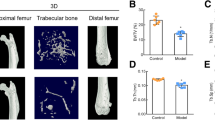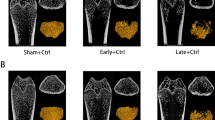Abstract
Previous studies have demonstrated the beneficial effect of melatonin (MEL) on bone tissue and bone metabolism. Rapamycin (RAP) promotes osteoblast proliferation and inhibits osteoclast proliferation, and positively affects bone regeneration; however, reports about effects of RAP on bone loss for aged female rats with MEL administration are limited. This study investigated the impact of treatment with RAP on bone loss for aged female rats with MEL administration. Female Sprague-Dawley rats weighing approximately 520 g were randomly divided into 3 groups of 10: group CON, group MEL and group MEL + RAP and received saline, MEL, RAP plus MEL treatment until death at 12 weeks, respectively. The results of maintaining bone mass and bone strength with RAP plus MEL administration were evaluated by histology, microcomputerized tomography (Micro-CT), gene expression analysis and biomechanical testing. Results from this study indicated that MEL + RAP had stronger effects on the prevention and treatment of osteoporosis than MEL administration. Administration of MEL + RAP produced the strongest effects on bone parameters and strength for distal femurs and regulation of OPG/RANKL signalling pathway-related gene expression. These results seemed to indicate that RAP could increase the effects of MEL on age-dependent bone loss.
Zusammenfassung
Frühere Studien haben die positive Wirkung von Melatonin (MEL) auf das Knochengewebe und den Knochenstoffwechsel gezeigt. Rapamycin (RAP) fördert die Osteoblastenproliferation, hemmt die Osteoklastenproliferation und wirkt sich positiv auf die Knochenregeneration aus. Berichte über die Auswirkungen von RAP auf den Knochenverlust bei älteren weiblichen Ratten mit MEL-Verabreichung sind jedoch begrenzt. Diese Studie untersuchte die Auswirkungen der RAP-Behandlung auf den Knochenabbau bei älteren weiblichen Ratten mit MEL-Gabe. Weibliche Sprague-Dawley-Ratten mit einem Gewicht von ca. 520 g wurden in 3 Gruppen randomisiert: Gruppe CON, Gruppe MEL und Gruppe MEL + RAP. Sie erhielten eine Behandlung mit entweder Kochsalzlösung, MEL- oder RAP plus MEL bis zum Tod nach 12 Wochen. Die Ergebnisse der Erhaltung der Knochenmasse und Knochenstärke mit der Verabreichung von MEL + RAP wurden durch Histologie, Mikro-Computertomographie (Mikro-CT), Genexpressionsanalyse und biomechanische Tests bewertet. Die Ergebnisse dieser Studie zeigten, dass MEL + RAP stärkere Auswirkungen auf die Prävention und Behandlung von Osteoporose hatte als die Gabe von MEL. Die Verabreichung von MEL + RAP hatte die stärksten Auswirkungen auf die Knochenparameter sowie die Festigkeit des distalen Femurs und die Regulation der OPG/RANKL-Signalweg-bezogenen Genexpression. Diese Ergebnisse schienen darauf hinzudeuten, dass RAP die Auswirkungen von MEL auf den altersbedingten Knochenabbau verstärken könnte.







Similar content being viewed by others
References
Birkhäuser M (2012) Selective Estrogen Receptor Modulators (SERMs) for prevention and treatment of postmenopausal osteoporosis. Ther Umsch 69(3):163–172
Deselm CJ, Zou W, Teitelbaum SL (2012) Halofuginone prevents estrogen-deficient osteoporosis in mice. J Cell Biochem 113(10):3086–3092
Lou S, Lv H, Li Z, Zhang L, Tang P (2018) Combination therapy of anabolic agents and bisphosphonates on bone mineral density in patients with osteoporosis: a meta-analysis of randomised controlled trials. Bmj Open 8(3):e15187
Qin S, Zhang Q, Zhang L (2017) Effect of OPG gene mutation on protein expression and biological activity in osteoporosis. Exp Ther Med 14(2):1475–1480
Tabatabaeimalazy O, Salari P, Khashayar P, Larijani B (2017) New horizons in treatment of osteoporosis. Daru 25(1):2
Liu J, Zhong R, Wei X, Liu H, Eisenegger C, Zhou X (2017) Melatonin increases reactive aggression in humans. Psychopharmacology 234(19):2971–2978
Hardeland R, Madrid JA, Tan DX, Reiter RJ (2012) Melatonin, the circadian multioscillator system and health: the need for detailed analyses of peripheral melatonin signaling. J Pineal Res 52(2):139–166
Salido EM, Melina B, Andrea DL, Mónica C, María IKS, Damián D et al (2013) Therapeutic efficacy of melatonin in reducing retinal damage in an experimental model of early type 2 diabetes in rats. J Pineal Res 54(2):179–189
María Piedad RF, Luis JCG, Arcesio RDR, Bruno N, Guillermo PZ, David PA et al (2013) Melatonin promotes angiogenesis during repair of bone defects: a radiological and histomorphometric study in rabbit tibiae. Clin Oral Invest 17(1):147–158
Oktem G, Uslu S, Vatansever SH, Aktug H, Yurtseven ME, Uysal A (2006) Evaluation of the relationship between inducible nitric oxide synthase (iNOS) activity and effects of melatonin in experimental osteoporosis in the rat. Surg Radiol Anat 28(2):157–162
Mizushima N (2007) Autophagy: process and function. Genes Dev. https://doi.org/10.1101/gad.1599207
Brinda R, Coralie V, Zdenek B, Davies JE, Shouqing L, Oroz LG et al (2004) Inhibition of mTOR induces autophagy and reduces toxicity of polyglutamine expansions in fly and mouse models of Huntington disease. Nat Genet 36(6):585–595
Luo D, Ren H, Li T, Lian K, Lin D (2015) Rapamycin reduces severity of senile osteoporosis by activating osteocyte autophagy. Osteoporos Int 27(3):1–9
Luo D, Ren H, Li T, Lian K, Lin D (2016) Rapamycin reduces severity of senile osteoporosis by activating osteocyte autophagy. Osteoporos Int 27(3):1093–1101. https://doi.org/10.1007/s00198-015-3325-5
Acikan I et al (2018) Systemic melatonin application increases bone formation in mandibular distraction osteogenesis. Braz Oral Res 32:e85
Li X, Ominsky MS, Warmington KS, Morony S, Gong J, Cao J et al (2010) Sclerostin antibody treatment increases bone formation, bone mass, and bone strength in a rat model of postmenopausal osteoporosis. J Bone Miner Res 24(4):578–588
Tao ZS, Lv YX, Cui W, Huang ZL, Tu KK, Zhou Q et al (2016) Effect of teriparatide on repair of femoral metaphyseal defect in ovariectomized rats. Z Gerontol Geriatr 49(5):423–428. https://doi.org/10.1007/s00391-015-0949-1
Tao ZS, Qiang Z, Tu KK, Huang ZL, Xu HM, Sun T et al (2015) Treatment study of distal femur for parathyroid hormone (1–34) and beta-tricalcium phosphate on bone formation in critical size defects in rats. J Biomater Appl 30(4):484–491. https://doi.org/10.1177/0885328215592854
Chen L, Tao ZS, Chen H, Zhou K, Zhou DS (2017) Combined treatment with alendronate and Drynaria rhizome extracts: effect on fracture healing in osteoporotic rats. Z Gerontol Geriatr. https://doi.org/10.1007/s00391-017-1326-z
Tao ZS, Zhou WS, Wu XJ, Zhang X, Wang L, Xie JB et al (2019) Prevention of ovariectomy-induced osteoporosis in rats: comparative study of zoledronic acid, parathyroid hormone (1–34) and strontium ranelate. Z Gerontol Geriatr 52(2):139–147. https://doi.org/10.1007/s00391-018-1376-x
Fabien W, Claire P, Laurent L, Sylvie M, Marie-Jeanne D, Patrice L et al (2013) The free fatty acid receptor G protein-coupled receptor 40 (GPR40) protects from bone loss through inhibition of osteoclast differentiation. J Biol Chem 288(9):6542–6551
Tao ZS et al (2019) Local administration of aspirin with β‑tricalcium phosphate/poly-lactic-co-glycolic acid (β-TCP/PLGA) could enhance osteoporotic bone regeneration. J Bone Miner Metab. https://doi.org/10.1007/s00774-019-01008-w
Koyama H, Nakade O, Takada Y, Kaku T, Lau K‑HW (2010) Melatonin at pharmacologic doses increases bone mass by suppressing resorption through down-regulation of the RANKL-mediated osteoclast formation and activation. J Bone Miner Res 17(7):1219–1229
Shalini S, Radio NM, Kotlarczyk MP, Chien-Tsun C, Yau-Huei W, Ralf J et al (2011) Determination of the minimal melatonin exposure required to induce osteoblast differentiation from human mesenchymal stem cells and these effects on downstream signaling pathways. J Pineal Res 50(3):222–238
Kotlarczyk MP, Lassila HC, O’Neil CK, D’Amico F, Enderby LT, Witt-Enderby PA et al (2012) Melatonin osteoporosis prevention study (MOPS): a randomized, double-blind, placebo-controlled study examining the effects of melatonin on bone health and quality of life in perimenopausal women. J Pineal Res 52(4):414–426
Sailaja Devi MM, Suresh Y, Das UN (2010) Preservation of the antioxidant status in chemically-induced diabetes mellitus by melatonin. J Pineal Res 29(2:108–115
Palin LP, Polo TOB, Batista FRDS, Garcia IR, Rossi AC, Freire A et al (2018) Daily melatonin administration improves osseointegration in pinealectomized rats. J Appl Oral Sci. https://doi.org/10.1590/1678-7757-2017-0470
Guardia J et al (2011) Evaluation of effects of topic melatonin on implant surface at 5 and 8 weeks in beagle dogs. Clin Implant Dent Relat Res 13(4):262–268
Yilmaz H et al (2018) Antioxidant role of melatonin against nicotine’s teratogenic effects on embryonic bone development. Iran J Basic Med Sci 21(8):787–793
Nakade O, Koyama H, Ariji H, Yajima A, Kaku T (2010) Melatonin stimulates proliferation and type I collagen synthesis in human bone cells in vitro. J Pineal Res 27(2):106–110
Shen G, Ren H, Qiu T, Zhang Z, Zhao W, Yu X et al (2017) Mammalian target of rapamycin as a therapeutic target in osteoporosis. J Cell Physiol. https://doi.org/10.1002/jcp.26161
Lingling X, Xiangwei W, Lijuan P, Michael L, Clifford JR, Tao Q et al (2012) Matrix IGF‑1 maintains bone mass by activation of mTOR in mesenchymal stem cells. Nat Med 18(7):1095–1101
Jianquan C, Xiaolin T, Emel E, Kyu SJ, Congxin L, Jeffrey MA et al (2014) WNT7B promotes bone formation in part through mTORC1. PLoS Genet 10(1):e1004145
Lim J et al (2016) Dual function of Bmpr1a signaling in restricting preosteoblast proliferation and stimulating osteoblast activity in mouse. Development 143(2):339
Liu Q, Liu C, Yang Y, Yang H, Chen J (2018) Osteocyte-intrinsic mTORC1 signaling restrains trabecular bone accrual in mice. J Cell Biochem 119(11):8743–8749. https://doi.org/10.1002/jcb.27470
Dai Q, Han Y, Xie F, Ma X, Xu Z, Liu X et al (2018) A RANKL-based osteoclast culture assay of mouse bone marrow to investigate the role of mTORC1 in osteoclast formation. J Vis Exp. https://doi.org/10.3791/56468
Lee KW, Yook JY, Son MY, Kim MJ, Koo DB, Han YM et al (2010) Rapamycin promotes the osteoblastic differentiation of human embryonic stem cells by blocking the mTOR pathway and stimulating the BMP/Smad pathway. Stem Cells Dev 19(4):557–568
Darcy A, Meltzer M, Miller J, Lee S, Chappell S, Donck KV et al (2012) A novel library screen identifies immunosuppressors that promote osteoblast differentiation. Bone 50(6):1294–1303
Funding
This study was supported by a grant from the University Natural Science Research Project of Anhui Province (CN) (grant no. KJ2017A266), and funding of Peak Training Program and Pan feng Innovation Team Project for Scientific Research of Yijishan Hospital, Wannan Medical College(grant nos. GF2019G04, PF2019005, GF2019T02 and PF2019007).
Author information
Authors and Affiliations
Corresponding authors
Ethics declarations
Conflict of interest
Z.‑S. Tao, H.‑L. Lu, N.‑F. Ma, R.‑T. Zhang, Y. Li, M. Yang and H.‑G. Xu declare that they have no competing interests.
Ethical standards
All procedures performed in studies involving animals were in accordance with the ethical standards of the institutional and/or national research committee and with the 1975 Helsinki declaration and its later amendments or comparable ethical standards.
Rights and permissions
About this article
Cite this article
Tao, ZS., Lu, HL., Ma, NF. et al. Rapamycin could increase the effects of melatonin against age-dependent bone loss. Z Gerontol Geriat 53, 671–678 (2020). https://doi.org/10.1007/s00391-019-01659-4
Received:
Accepted:
Published:
Issue Date:
DOI: https://doi.org/10.1007/s00391-019-01659-4




